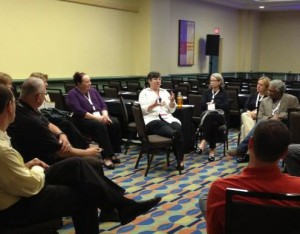 I spent the past week in Orlando, FL learning about online education. As a part of that experience, I attended (along with 1500+ in Orlando and 1200+ virtual attendees) the 18th Annual Sloan Consortium International Conference on Online Learning.
I spent the past week in Orlando, FL learning about online education. As a part of that experience, I attended (along with 1500+ in Orlando and 1200+ virtual attendees) the 18th Annual Sloan Consortium International Conference on Online Learning.
The Sloan conference offered hundreds of formal learning opportunities alongside several scheduled networking events. While I was in the minority as a first time attendee, I had no trouble finding my way into any and all of the possibilities that intrigued me. The electronic conversation on Twitter created a rich virtual community. As the conference progressed, I found myself constantly using my tablet, smartphone and/or laptop to observe and contribute to the #aln12 stream.
On the final morning of the event, I hosted a tweetup. As I listened to people share, I began to view the wisdom of their tweets from a new perspective. While I would go on to attend a few more sessions, it was in the tweetup circle comprised of some twenty persons that the conference came together for me. I am certain I will become a better online educator as I process the words those colleagues shared (both spoken and tweeted), review the session materials, and reflect on my experiences.
So What?
There has been, is, and likely will continue to be considerable discussion about creating community. Whether in higher education or in the religious life of a specific faith community, the power of both/and thinking must be leveraged in cultivating community.
- What is the proper balance of face-to-face versus virtual community in your congregation? Can the two be separated or are they so intertwined in your system that any attempts to separate them are artificial in nature?
- If your congregation meets primarily in face-to-face settings, how does your leadership seek to intentionally enhance connections and relationships using social media?
- If your congregation meets primarily online, does your leadership provide occasional intentional opportunities for face-to-face gatherings?